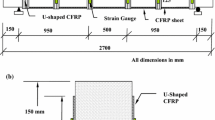Abstract
Steel corrosion in reinforced concrete leads to crack occurrence along the reinforcement (secondary cracks), to a reduction in bond strength and a reduction in steel cross section. The purpose of this study is to determine the effect of these deteriorations on the global behaviour of reinforced concrete structural elements in their service and ultimate states. Mechanical experimentation was carried out on fourteen-year-old reinforced concrete beams, on two control elements and two corroded beams. A comparative analysis of the results obtained on the beams showed that concrete cracking in the compressive area had no significant influence on the behaviour in service of the corroded elements. However, significant modifications of service behaviour were observed, due to the degradations in the tensile zone, namely: loss of bending stiffness, dissymmetrical behaviour. Finally, the measure of the residual steel cross-section of the corroded re-bars showed that the loss of bending stiffnes due to steel corrosion cannot be merely explained in terms of steel cross-section reduction. Concerning the ultimate behaviour, the loss of steel cross-section is the main parameter which leads to a reduction of bearing capacity and ductility. Another part will explain the separate and coupling effects of bond strength and steel cross-section loss on the mechanical behaviour of corroded beams.
Résumé
La corrosion des armatures dans le béton armé entraîne une fissuration du béton d’enrobage qui traduit à la fois une réduction de section des aciers et une perte d’adhérence acier-béton. L’objectif de ce travail est d’étudier l’influence de ces dégradations sur le comportement global, en service puis à rupture, des éléments de structure. Pour ce faire, des expérimentations mécaniques ont été réalisées sur des poutres corrodées, ceci en comparaison avec le comportement d’éléments témoins. L’analyse comparative des résultats obtenus a montré que la fissuration du béton comprimé n’a pas d’influence sur le comportement en service. En effet, ce sont les dégradations en partie tendue qui entraînent des modifications importantes, notamment une réduction de la raideur en flexion et un comportement dissymétrique. De plus, l’analyse des taux de corrosion le long des armatures tendues semble montrer que la perte d’adhérence acierbéton a une influence très significative. En ce qui concerne le comportement à rupture, la réduction de section d’acier est le seul paramètre déterminant. Elle entraîne une diminution de la capacité portante et de la ductilité. Une seconde partie sera dédiée à l’étude plus détaillée de l’effet couplé ou découplé de la réduction de section d’acier et de la perte d’adhérence acier-béton en partie tendue sur le comportement mécanique local et global des poutres corrodées.
Similar content being viewed by others
References
Cabrera, J. G., ‘Deterioration of concrete due to reinforcement steel corrosion’,Cement and Concrete Research 18 (1) (1996) 47–59.
Rodriguez, J., Ortega, L. M., Casal, J. and Diez, J. M., ‘Corrosion of reinforcement and service life of concrete structures’, Durability of Building materials and components 7, (Edited by C. Sjöström, 1996) 117–126.
Andrade, C., Alonso, C. and Molina, F. J., ‘Cover cracking as a function of bar corrosion’.Mater. Struct. 26 (1993) 453–464.
Mircea, D., Ioani, A., Filip, M. and Pepenar, I., ‘Long-term durability of reinforced and prestressed elements in aggressive environments’,A.C.I. Materials Journal 91 (2) (1994) 135–140.
Al-Sulaimani, G. J., Kaleemullah, M., Basunbul, I. A. and Rasheeduzzafar, M., ‘Influence of corrosion and cracking on bond behaviour and strength of reinforced concrete members’,A.C.I. Materials Journal 87 (2) (1990) 220–231.
François, R., Arliguie, G. and Castel, A., “Influence of service cracking on service life of reinforced concrete’, Conference on Concrete under Severe Conditions, Proceedings of an International Conference, CONSEC’98, Norway (1998).
Tachibana, Y., Kajikawa, Y. and Kawamura, M., ‘The behaviour of RC-beams, damaged by corrosion of reinforcement’, Proceedings of Japan Society of Civil Engineers (1989) 105–114.
Sulaimani, G. J., ‘Influence of corrosion and cracking on bond behaviour and strength of reinforced concrete members’.A.C.I. Structural Journal 87 (1990) 220–231.
Lee, H. S., Tomosawa, F. and Noguchi, T., ‘Effects of re-bar corrosion on the structural performance of singly reinforced beams’, 7th D.B.M.C., Proceedings of an International Conference, 1 (1992) 571–580.
François, R. and Arliguie, G., ‘Reinforced concrete: Correlation between cracking and corrosion’, 2nd CANMET/ACI International Conference on Durability of concrete, Proceedings of an International Conference, SPI26 2 (Montreal 1991).
French Regulations for Reinforced Concrete Structures B.A.E.L. (1983).
François, R., Arliguie, G. and Maso, J. C., ‘Durabilité du béton armé’, Rapport de synthèse. L.M.D.C. I.N.S.A.-U.P.S. Toulouse, France (1994).
Rodriguez, J., Ortega, L. M., Casal, J. and Diez, J. M., ‘Assessing structural conditions of concrete structures with corroded reinforcements’, 4th Int. Congress on concrete in the service mankind, Proceedings of an International Conference, Dundee, UK (1996).
Sanz, G., ‘La rupture des aciers-Effet d’une entaille’, Propriétés d’emploi des aciers, Collection IRSID-OTUA.
Author information
Authors and Affiliations
Additional information
Editorial Note Prof. Ginette Arliguie is a RILEM Senior Member. She works at LMDC (Laboratoire Matériaux et Durabilité des Constructions), a RILEM Titular Member.
Rights and permissions
About this article
Cite this article
Castel, A., François, R. & Arliguie, G. Mechanical behaviour of corroded reinforced concrete beams—Part 1: Experimental study of corroded beams. Mat. Struct. 33, 539–544 (2000). https://doi.org/10.1007/BF02480533
Received:
Accepted:
Issue Date:
DOI: https://doi.org/10.1007/BF02480533




